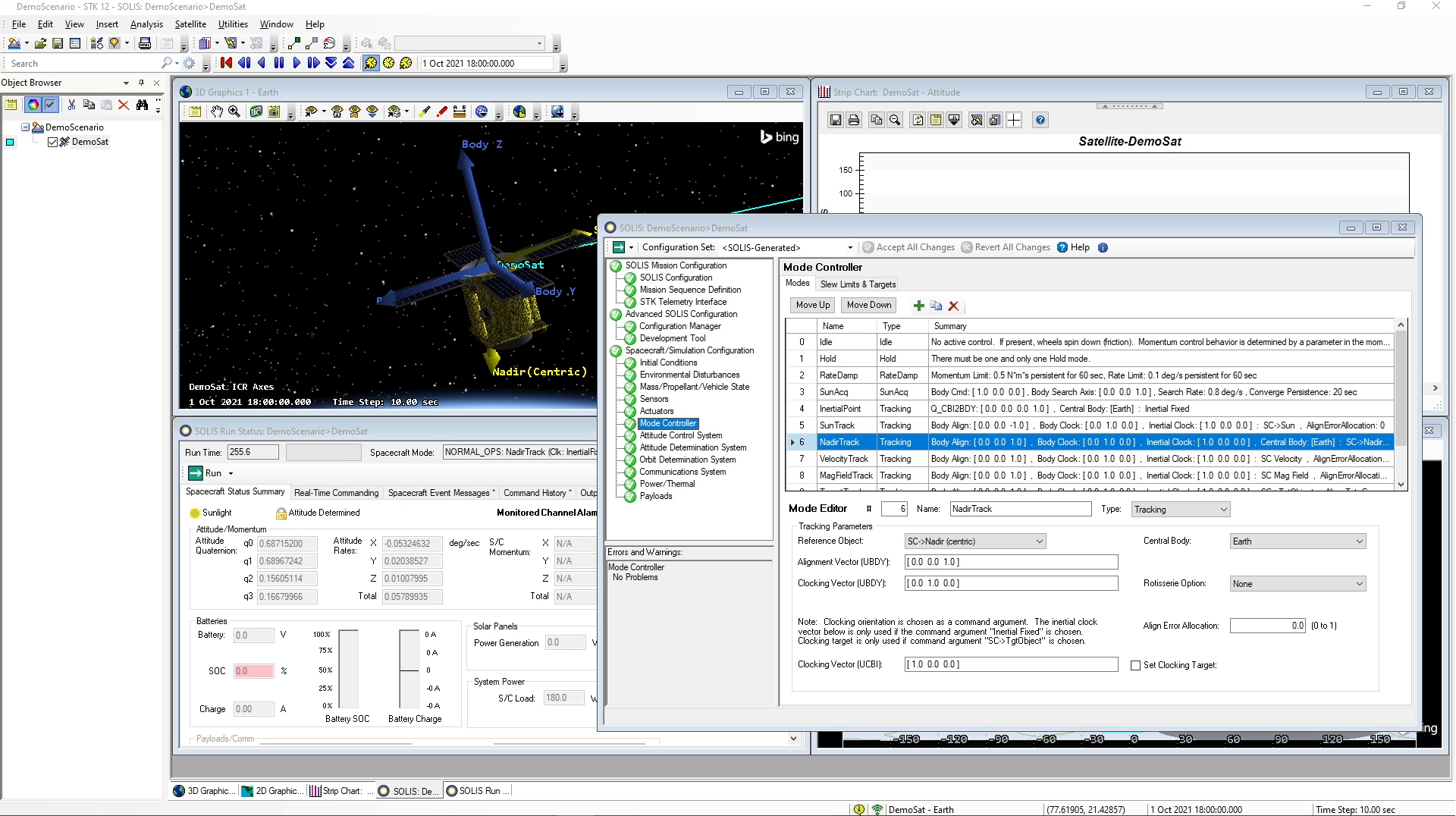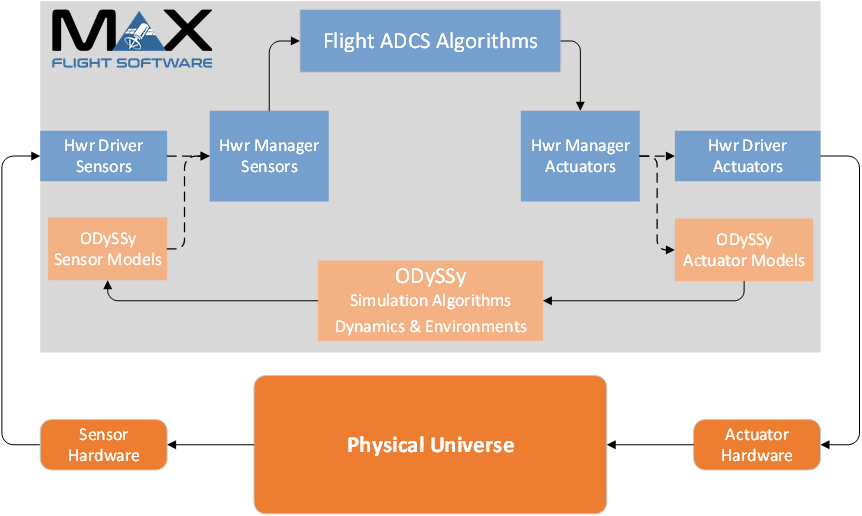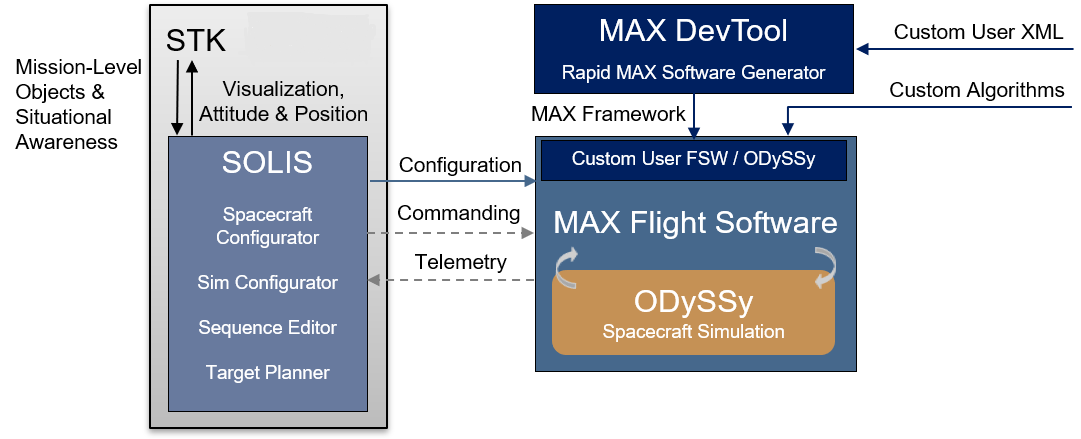
SOLIS is a commercial plug-in to the Ansys, Inc Systems ToolKit (STKTM) mission analysis software, providing integrated end-to-end spacecraft simulation. Running MAX Flight Software and ODySSy, SOLIS provides simulation capabilities of all major spacecraft subsystems.
Graphical-interface simplifies configuration of spacecraft subsystems, simulation setup, and analysis
- "Wizards" are provided to simplify the configuration of complex systems
- Variable levels of subsystem fidelity for rapid or detailed analysis
- Flight code and command/telemetry databases are dynamically configured and can be targeted for specified computing-platform
- Supports rapid analysis for design tradeoffs, capability assessments, and constraint evaluation
Running actual flight software built on the MAX Flight Software framework
- Commanding the simulation is identical to commanding an actual spacecraft
- A Command/Telemetry bridge process provides capability to interact with user-specific custom databases
- Leverages full-featured sequencing language; permitting features such as fault monitoring and response
- Generation of sequences is simplified through the use of the Sequence Editor and Target Planner
Fully-integrated with the DevTool to support custom algorithms and simulation components that interact with the core spacecraft
Evaluation of spacecraft and mission design requires substantial modeling of the space and ground environments. Leveraging the capabilities of STK; SOLIS provides a spacecraft simulation with unmatched:
- Visual representation
- Situational awareness
- Mission planning
- Environment modeling
- Multi-object interaction
- System observability
This combination empowers you to rapidly develop, analyze, and test solutions to many complex problems.
Flight software configured from SOLIS can be targeted for actual flight avionics with limited effort
- The same tools that accelerated the design and analysis cycle now yield similar benefits throughout AI&T and operations
- As a consistent partner from concept through operations; SOLIS ensures seamless transition across program phases and a true “test like you fly” approach from the beginning
SOLIS Capabilities

- Attitude Disturbance Modeling
- Magnetic dipole, gravity gradient, solar and aerodynamic forces
- Attitude Determination Modeling / Guidance
- Sun sensors, horizon sensors, rate sensors, IMUs, magnetometers, star trackers, simulated GPS
- Perfect attitude determination, fixed-gain filter, Kalman filter
- Orbit determination, ephemeris propagation
- Attitude Control Modeling
- Reaction wheels, magnetic torquers, thrusters
- Perfect control, PIID control
- Mode Control
- Idle, Inertial Hold, Rate Damp
- Numerous Tracking and Clocking Modes: Inertial Point, Sun Track, Nadir Track, Velocity Track, Mag Field Track, Target Tracking, Inertial Vector Tracking, Orbit Normal Track, Surface Relative Velocity Track, Rotisserie, External Guidance, Nadir Scan, Lat/Lon Scan
- Eigen-Axis Slew, Optimized "Rendez-Slew"
- Power/Thermal Modeling
- Distance-dependent solar flux, central body infrared, albedo
- Finite element thermal; absorptivity, emissivity, conductivity, shunt
- Solar panel size, efficiency, articulation, temperature dependency
- Battery capacity, charge/discharge regulation
- Dynamic spacecraft loads; payload power, comm system power, reaction wheel power
- Payload/Communications/Data Modeling
- Off, On, Standby
- Define multiple payload modes; power consumption, data collection
- Transmitters, receivers, transceivers; data rates, overhead, power consumption
- Data recorder size, current state
- Command/telemetry availability when ground stations are visible
- Flight Emulation
- Mission sequence modeling, real-time commanding, telemetry

Applications
Spacecraft Design
- System/Mission Requirements
- Requirements definition, feasibility studies, component selection
- Conceptual Design
- Analyze various system concepts to determine which can meet mission requirements
- Preliminary Design
- Variations of conceptual designs are analyzed and refined
- Define subsystem and component level specifications
- Critical Design
- Final design verification of subsystem models and components
- Risk Reduction and IV&V
- Independent validation and sensitivity/margin analysis
Spacecraft Operations
- Training and analysis tool for ground operators and mission analysts
Associated Software
SOLIS leverages many useful aspects of STK alongside other products from ASI to produce a fully-integrated simulation tool.
MAX Flight Software
MAX Flight Software (Modular, Autonomous, eXtendible) is the underlying flight software and simulation code, written in C++, used by SOLIS. MAX is built out of Components and Objects that are configured and connected based on the user-specified setup within SOLIS.
ODySSy
ODySSy (Onboard Dynamic Simulation System) is a full-featured spacecraft simulation engine built directly into the MAX Flight Software. ODySSy is used to form a closed-loop environment around the flight software by modeling all aspects of the ADCS and other subsystems.

MAX Development Tool
For customized code within the SOLIS framework, the MAX Development Tool enables you to make endless additions and modifications to the standard SOLIS/MAX configuration.
